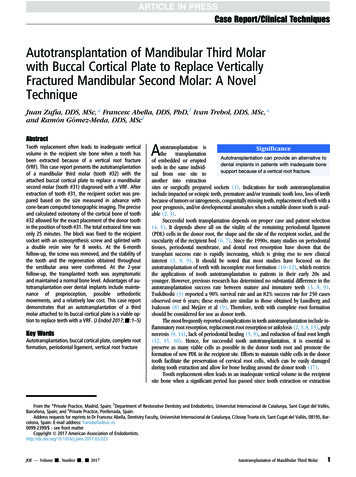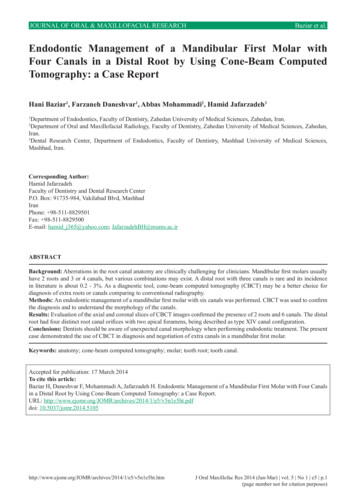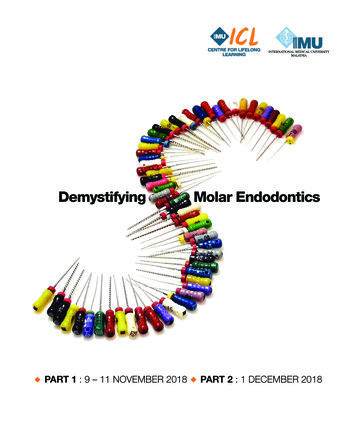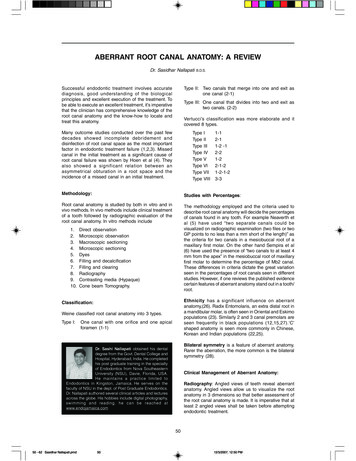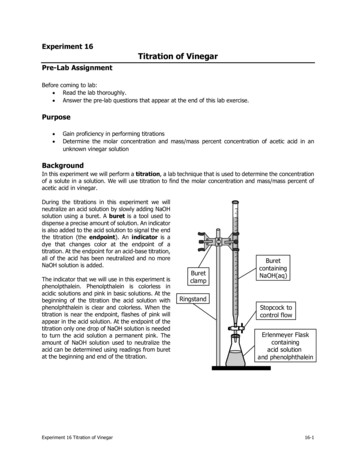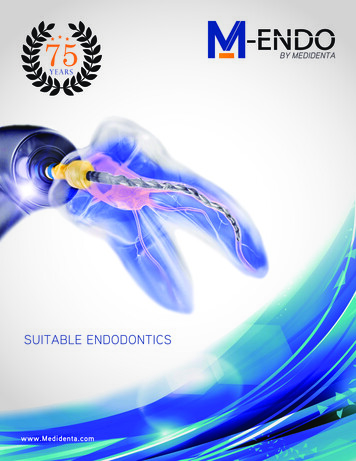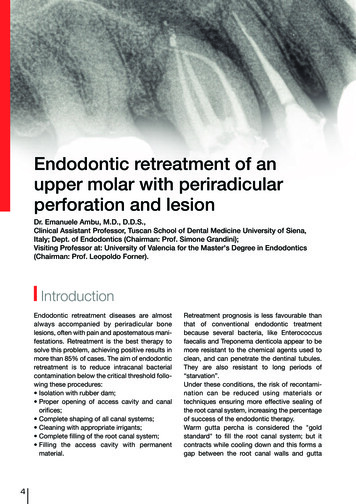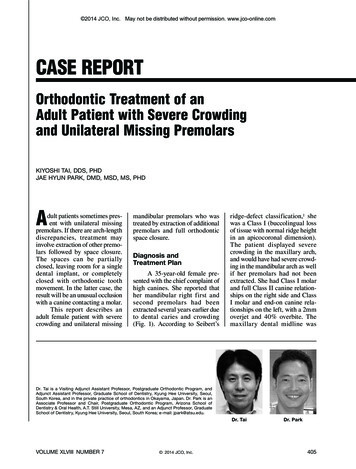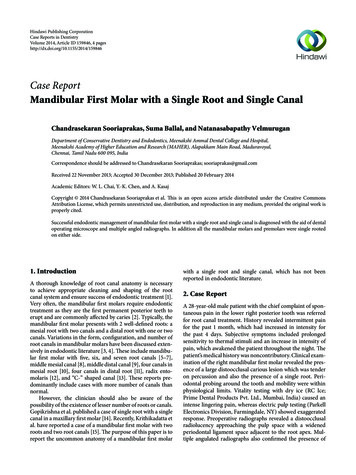
Transcription
Hindawi Publishing CorporationCase Reports in DentistryVolume 2014, Article ID 159846, 4 pageshttp://dx.doi.org/10.1155/2014/159846Case ReportMandibular First Molar with a Single Root and Single CanalChandrasekaran Sooriaprakas, Suma Ballal, and Natanasabapathy VelmuruganDepartment of Conservative Dentistry and Endodontics, Meenakshi Ammal Dental College and Hospital,Meenakshi Academy of Higher Education and Research (MAHER), Alapakkam Main Road, Maduravoyal,Chennai, Tamil Nadu 600 095, IndiaCorrespondence should be addressed to Chandrasekaran Sooriaprakas; sooriaprakas@gmail.comReceived 22 November 2013; Accepted 30 December 2013; Published 20 February 2014Academic Editors: W. L. Chai, Y.-K. Chen, and A. KasajCopyright 2014 Chandrasekaran Sooriaprakas et al. This is an open access article distributed under the Creative CommonsAttribution License, which permits unrestricted use, distribution, and reproduction in any medium, provided the original work isproperly cited.Successful endodontic management of mandibular first molar with a single root and single canal is diagnosed with the aid of dentaloperating microscope and multiple angled radiographs. In addition all the mandibular molars and premolars were single rootedon either side.1. IntroductionA thorough knowledge of root canal anatomy is necessaryto achieve appropriate cleaning and shaping of the rootcanal system and ensure success of endodontic treatment [1].Very often, the mandibular first molars require endodontictreatment as they are the first permanent posterior teeth toerupt and are commonly affected by caries [2]. Typically, themandibular first molar presents with 2 well-defined roots: amesial root with two canals and a distal root with one or twocanals. Variations in the form, configuration, and number ofroot canals in mandibular molars have been discussed extensively in endodontic literature [3, 4]. These include mandibular first molar with five, six, and seven root canals [5–7],middle mesial canal [8], middle distal canal [9], four canals inmesial root [10], four canals in distal root [11], radix entomolaris [12], and “C-” shaped canal [13]. These reports predominantly include cases with more number of canals thannormal.However, the clinician should also be aware of thepossibility of the existence of lesser number of roots or canals.Gopikrishna et al. published a case of single root with a singlecanal in a maxillary first molar [14]. Recently, Krithikadatta etal. have reported a case of a mandibular first molar with tworoots and two root canals [15]. The purpose of this paper is toreport the uncommon anatomy of a mandibular first molarwith a single root and single canal, which has not beenreported in endodontic literature.2. Case ReportA 28-year-old male patient with the chief complaint of spontaneous pain in the lower right posterior tooth was referredfor root canal treatment. History revealed intermittent painfor the past 1 month, which had increased in intensity forthe past 4 days. Subjective symptoms included prolongedsensitivity to thermal stimuli and an increase in intensity ofpain, which awakened the patient throughout the night. Thepatient’s medical history was noncontributory. Clinical examination of the right mandibular first molar revealed the presence of a large distoocclusal carious lesion which was tenderon percussion and also the presence of a single root. Periodontal probing around the tooth and mobility were withinphysiological limits. Vitality testing with dry ice (RC Ice;Prime Dental Products Pvt. Ltd., Mumbai, India) caused anintense lingering pain, whereas electric pulp testing (ParkellElectronics Division, Farmingdale, NY) showed exaggeratedresponse. Preoperative radiographs revealed a distoocclusalradiolucency approaching the pulp space with a widenedperiodontal ligament space adjacent to the root apex. Multiple angulated radiographs also confirmed the presence of
2Case Reports in Dentistry(a)(b)(c)(d)Figure 1: (a) Preoperative radiograph showing the posterior teeth with single root. (b) Access opening demonstrating single canal.(c) Working length radiograph. (d) Postobturation radiograph.a single root and a single canal (Figure 1(a)). From the clinicaland radiographic examination, a diagnosis of symptomaticirreversible pulpitis with symptomatic apical periodontitiswas made and hence routine nonsurgical endodontic treatment was planned.Local anesthesia was induced using 1.8 mL 2% lidocaine with 1 : 200,000 epinephrine (Xylocaine; AstraZenecaPharma India Ltd., Bangalore, India). Following caries excavation the distal surface of the tooth was restored with IRM(IRM; Dentsply De Trey GmbH, Konstanz, Germany). Rubber dam was placed and a conventional endodontic accessopening was established with an Endo Access bur (DentsplyTulsa, Tulsa, OK). On access opening, a single large canal waslocated in the centre of the pulp chamber. Usually a singlerooted mandibular molar could be associated with C-shapedcanal but in this case a “C-” shaped orifice/canal was not identified, instead a single large canal was present at the centre ofthe pulp chamber which was confirmed using dental operating microscope (Seiler Revelation, St. Louis, MO, USA)(Figure 1(b)).Working length was determined using radiographs(Ingle’s method) and confirmed with an apex locator (RootZX II, Morita, Tokyo, Japan) (Figure 1(c)). Cleaning and shaping was done using circumferential filing technique with ISO2% taper files up to size 60 (MANI Inc., Tochigi-Ken, Japan).Irrigation was performed using normal saline (Nirma Pvt.limited, Gujarat, India), 2.5% sodium hypochlorite solution,and 17% EDTA (Prime Dental Product Pvt. Ltd., Mumbai,India). Final rinsing of the canal was performed using 2%chlorhexidine digluconate coupled with ultrasonic agitation.The canal was dried with absorbent points (Dentsply Maillefer Instruments, Ballaigues, Switzerland) and obturation wasperformed using cold lateral compaction of gutta-percha(Dentsply Maillefer Instruments, Ballaigues, Switzerland)and AH Plus resin sealer (Maillefer Dentsply, Konstanz,Germany) (Figure 1(d)). After completion of root canal treatment, the tooth was restored using resin composite (Z250;3M ESPE Dental Products, St. Paul, MN). The patient wasasymptomatic during the followup period of one year.3. DiscussionOur case report highlights the presence of an unusualanatomy in mandibular first molar that had a single root anda single canal. Sabala et al. [16] stated that the rarer the aberration is, the greater the probability of it being bilateral will be.Interestingly in the present case, all the mandibular posteriorteeth, both premolars and molars, had single root canal andsingle canal (Figure 2(a)). Also the right upper molars andpremolars had single root and single canal (Figure 2(b)).Left maxillary posteriors were extracted and hence the morphology could not be determined. Fava et al. [17] had identified the existence of such anatomical variation in secondmolars in all the maxillary and mandibular second molars.Majority of the permanent mandibular first molars typicallypresent with 2 well-defined roots, a mesial root with two
Case Reports in Dentistry3Table 1: The variations in mandibular first molar according to different authors.Materials andmethodsNumber of teethVariationsreportedDistribution of canalsNumber ofrootsCase report16 root canals3 mesial, 3 distal2 rootsCase report12 mesial, 3 distal2 rootsBolger and Schindler (1988) [13]Case report1Reeh (1998) [7]Case report1Baugh and Wallace (2004) [8]Case report1Ghoddusi et al. (2007) [11]Case report1Krithikadatta et al. (2010) [15]Case report1Kottoor et al. (2011) [23]Case report1Attam et al. (2012) [12]Case report3Subbiya et al. (2013) [10]Case report15 root canals“C” shapedcanal7 root canalsMiddle mesialcanalFour canals indistal root2 canalsMiddle distalcanalRadixentomolarisFour canals inmesial rootReuben et al. (2008) [20]In vitro1/125(Indian population)Author/yearMartı́nez-Berná and Badanelli(1985) [6]Beatty and Interian (1985) [5](a)Single canal2 roots4 mesial, 3 distal2 roots3 mesial, 2 distal2 roots2 mesial, 4 distal4 roots1 mesial, 1 distal2 roots2 mesial, 3 distal2 rootsDistolingual root in each case3 roots4 mesial, 2 distal2 rootsSingle canal (in the centre ofthe pulp chamber)1 root(b)Figure 2: (a) Radiograph shows all the mandibular posterior teeth: contralateral side. (b) Radiograph shows all the right maxillary posteriorteeth with single root.canals and a distal root with a wide oval canal or 2 roundcanals [3]. Apart from these presentations, wide variations ofroot and canal configuration of the mandibular first molarshave been reported in the literature [5–13].The mandibular first molars erupt at the age of 6-7 yearsand apical closure is usually completed by 8-9 years. Thecompletion of canal differentiation commences at about 3–6years after root completion [15]. Any disturbances in this differentiation could have resulted in this type of canal anatomy.Systematic review of literature on canal morphology ofthe mandibular first molar by Valencia De Pablo et al. [18] andBallulaya et al. [19] has not documented this rare morphology.But this morphological variation has been documented onlyonce earlier in an in vitro study done by Reuben et al. [20].Out of 125 samples of mandibular first molars from an Indianpopulation, only one sample had a single root and singlecanal. Table 1 illustrates variations in mandibular first molaraccording to different authors.Radiographic examination is an essential componentin endodontic treatment. The use of multiple preoperativeradiographs or an additional radiographic view from a 20degree mesial or distal projection increases the chances ofdetecting unusual root canal morphology [21].Kottoor et al. [22, 23] and La et al. [24] have suggestedthe use of CBCT for the purpose of determining the rootcanal morphology in cases with aberrations. In this particularcase, multiple radiographs in variable horizontal angulationsclearly indicated the presence of single root and single canal.The root canal was located at the centre of the pulpalfloor and dentinal map was not evident. Searching for anextra canal in such cases could lead to excessive removalof dentin and even perforation. Since the single canal was
4Case Reports in Dentistrylarge, the enlargement was done using a circumferential filingtechnique using ISO taper files.[15]4. ConclusionThis case report highlights the uncommon anatomy ofmandibular first molar with a single root and single canal.Multiple preoperative radiographs, careful inspection of thetooth under dental operating microscopes, and the choice ofcleaning and shaping technique suitable for this uncommonroot canal anatomy enabled us to achieve success in this case.[16][17]Conflict of InterestsThe authors declare that there is no conflict of interestsregarding the publication of this paper.References[1] J. I. Ingle, L. K. Bakland, and J. C. Baumgartner, Endodontics, BC Decker, Hamilton, Canada, 6th edition, 2008.[2] S. Cohen and K. M. Hargreaves, Pathways of the Pulp, Mosby, StLouis, Mo, USA, 9th edition, 2006.[3] F. J. Vertucci, “Root canal anatomy of the human permanentteeth,” Oral Surgery Oral Medicine and Oral Pathology, vol. 58,no. 5, pp. 589–599, 1984.[4] A. E. Skidmore and A. M. Bjorndal, “Root canal morphology ofthe human mandibular first molar,” Oral Surgery, Oral Medicine,Oral Pathology, vol. 32, no. 5, pp. 778–784, 1971.[5] R. G. Beatty and C. M. Interian, “A mandibular first molar withfive canals: report of case,” The Journal of the American DentalAssociation, vol. 111, no. 5, pp. 769–771, 1985.[6] A. Martı́nez-Berná and P. Badanelli, “Mandibular first molarswith six root canals,” Journal of Endodontics, vol. 11, no. 8, pp.348–352, 1985.[7] E. S. Reeh, “Seven canals in a lower first molar,” Journal ofEndodontics, vol. 24, no. 7, pp. 497–499, 1998.[8] D. Baugh and J. Wallace, “Middle mesial canal of the mandibular first molar: a case report and literature review,” Journal ofEndodontics, vol. 30, no. 3, pp. 185–186, 2004.[9] J. Kottoor, R. Sudha, and N. Velmurugan, “Middle distal canal ofthe mandibular first molar: a case report and literature review,”International Endodontic Journal, vol. 43, no. 8, pp. 714–722,2010.[10] A. Subbiya, K. S. Kumar, P. Vivekanandhan, and V. Prakash,“Management of mandibular first molar with four canals inmesial root,” Journal of Conservative Dentistry, vol. 16, no. 5, pp.471–473, 2013.[11] J. Ghoddusi, N. Naghavi, M. Zarei, and E. Rohani, “Mandibularfirst molar with four distal canals,” Journal of Endodontics, vol.33, no. 12, pp. 1481–1483, 2007.[12] K. Attam, R. R. Nawal, S. Utneja, and S. Talwar, “Radix entomolaris in mandibular first molars in Indian population: a reviewand case reports,” Case Reports in Dentistry, vol. 2012, Article ID595494, 7 pages, 2012.[13] W. L. Bolger and W. G. Schindler, “A mandibular first molar witha C-shaped root configuration,” Journal of Endodontics, vol. 14,no. 10, pp. 515–519, 1988.[14] V. Gopikrishna, N. Bhargavi, and D. Kandaswamy, “Endodonticmanagement of a maxillary first molar with a single root and[18][19][20][21][22][23][24]a single canal diagnosed with the aid of spiral CT: a case report,”Journal of Endodontics, vol. 32, no. 7, pp. 687–691, 2006.J. Krithikadatta, J. Kottoor, C. S. Karumaran, and G. Rajan,“Mandibular first molar having an unusual mesial root canalmorphology with contradictory cone-beam computed tomography findings: a case report,” Journal of Endodontics, vol. 36,no. 10, pp. 1712–1716, 2010.C. L. Sabala, F. W. Benenati, and B. R. Neas, “Bilateral root orroot canal aberrations in a dental school patient population,”Journal of Endodontics, vol. 20, no. 1, pp. 38–42, 1994.L. R. G. Fava, I. Weinfeld, F. P. Fabri, and C. R. Pais, “Foursecond molars with single roots and single canals in the samepatient,” International Endodontic Journal, vol. 33, no. 2, pp. 138–142, 2000.Ó. V. De Pablo, R. Estevez, M. Péix Sánchez, C. Heilborn, andN. Cohenca, “Root anatomy and canal configuration of thepermanent mandibular first molar: a systematic review,” Journalof Endodontics, vol. 36, no. 12, pp. 1919–1931, 2010.S. V. Ballulaya, S. Vemuri, and P. R. Kumar, “Variable permanentmandibular first molar: review of literature,” Journal of Conservative Dentistry, vol. 16, no. 2, pp. 99–110, 2013.J. Reuben, N. Velmurugan, and D. Kandaswamy, “The evaluation of root canal morphology of the mandibular first molar inan Indian population using spiral computed tomography scan:an in vitro study,” Journal of Endodontics, vol. 34, no. 2, pp. 212–215, 2008.L. R. G. Fava and P. M. H. Dummer, “Periapical radiographictechniques during endodontic diagnosis and treatment,” International Endodontic Journal, vol. 30, no. 4, pp. 250–261, 1997.J. Kottoor, N. Velmurugan, R. Sudha, and S. Hemamalathi,“Maxillary first molar with seven root canals diagnosed withcone-beam computed tomography scanning: a case report,”Journal of Endodontics, vol. 36, no. 5, pp. 915–921, 2010.J. Kottoor, N. Velmurugan, and S. Surendran, “Endodonticmanagement of a maxillary first molar with eight root canalsystems evaluated using cone-beam computed tomographyscanning: a case report,” Journal of Endodontics, vol. 37, no. 5,pp. 715–719, 2011.S.-H. La, D.-H. Jung, E.-C. Kim, and K.-S. Min, “Identificationof independent middle mesial canal in mandibular first molarusing cone-beam computed tomography imaging,” Journal ofEndodontics, vol. 36, no. 3, pp. 542–545, 2010.
Advances inPreventive MedicineThe ScientificWorld JournalHindawi Publishing Corporationhttp://www.hindawi.comVolume 2014Case Reports inDentistryInternational Journal ofDentistryHindawi Publishing Corporationhttp://www.hindawi.comVolume 2014Hindawi Publishing Corporationhttp://www.hindawi.comScientificaVolume 2014Hindawi Publishing Corporationhttp://www.hindawi.comVolume 2014Volume 2014PainResearch and TreatmentInternational Journal ofBiomaterialsHindawi Publishing Corporationhttp://www.hindawi.comHindawi Publishing Corporationhttp://www.hindawi.comHindawi Publishing Corporationhttp://www.hindawi.comVolume 2014Volume 2014Journal ofEnvironmental andPublic HealthSubmit your manuscripts athttp://www.hindawi.comJournal ofOral ImplantsHindawi Publishing Corporationhttp://www.hindawi.comComputational andMathematical Methodsin MedicineHindawi Publishing Corporationhttp://www.hindawi.comHindawi Publishing Corporationhttp://www.hindawi.comVolume 2014Volume 2014Journal ofAdvances inOral OncologyHindawi Publishing Corporationhttp://www.hindawi.comVolume 2014Hindawi Publishing earch and PracticeJournal ofOrthopedicsDrug DeliveryVolume 2014Hindawi Publishing Corporationhttp://www.hindawi.comVolume 2014Volume 2014Hindawi Publishing Corporationhttp://www.hindawi.comVolume 2014Journal ofDental SurgeryJournal ofHindawi Publishing Corporationhttp://www.hindawi.comBioMedResearch InternationalInternational Journal ofOral DiseasesEndocrinologyVolume 2014Hindawi Publishing Corporationhttp://www.hindawi.comVolume 2014Hindawi Publishing Corporationhttp://www.hindawi.comVolume 2014Hindawi Publishing Corporationhttp://www.hindawi.comVolume 2014RadiologyResearch and PracticeHindawi Publishing Corporationhttp://www.hindawi.comVolume 2014
Maxillary rst molar with seven root canals diagnosed with cone-beam computed tomography scanning: a case report, Journal of Endodontics ,vol. ,no. ,pp. ,. [] J. Kottoor, N. Velmurugan, and S. Surendran, Endodontic management of a maxillary rst molar with eight root ca

